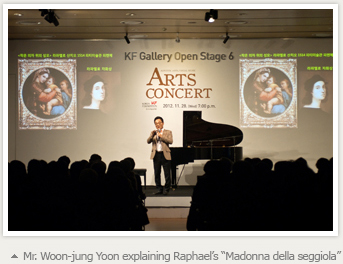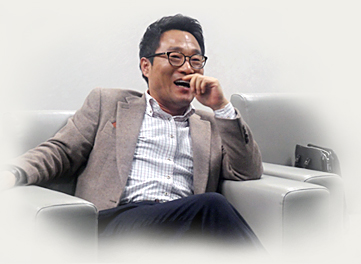The last performance of The KF Gallery 2012 Open Stage series was held at The Korea Foundation Cultural Center on November 28, 2012. This performance combined the fine arts and music, which made for a memorable winter night, with an art expert, Woon-joong Yoon; soprano, Kyung-ae Im; tenor, Dong-myung Kang; and pianist, Hye-young Yun.
Harmony of the fine arts and music
This performance harked back to the splendors of the western European Renaissance when there was a synthesis of art and music, which is reflected in its title, ''Acoustic Arts, Visual Music." Hence, the audience had the opportunity to partake of both music and the fine arts, which have been separated in the west since the Renaissance. Moreover, this performance focused on the irreducible interactions between
art and the personal lives and loves of great artists.
Four themes were explored at the concert: the Renaissance in Florence, city of flowers; Ave Maria; Moonlight Love; and Crossing Times. There was artwork of great artists such as Botticelli, Raphael, Shin Yun-bok, and Manet, along with musical masterpieces by Liszt, Verdi, Gounod, Puccini, and Debussy, as well as pop music by Yoshimata Ryo, ''The Whole Nine Yards," which was a song for the soundtrack in the film, ''Between Calm and Passion."
Knowledgeable and captivating storytelling about the fine arts
 Mr. Woon-joong Yoon, is a so-called ''walking fine arts encyclopedia," with knowledge about the artwork in five major European art museums; he captivated the audience with his educative and entertaining storytelling. The audience was enthralled with his account of how nine-year-old young Dante met and fell in love with Beatrice; while they broke out in laughter when Mr. Yoon masterfully explicated Shin Yun-bok's painting, ''Wolha-jeongin" (''Lovers under the Moon") and noted the woman's right foot, which was pointed in the opposite direction of the man, thus highlighting a moment of disharmony. The background and theme of Botticelli's ''Calumny of Apelles" was marvelously retold by Mr. Yoon as he recounted how Apelles, the greatest Greek painter of antiquity, was slandered by a jealous rival, Antiphilos, in front of the King Ptolemy I Soter of Egypt; Apelles then painted his lost masterpiece as the final word.
Mr. Woon-joong Yoon, is a so-called ''walking fine arts encyclopedia," with knowledge about the artwork in five major European art museums; he captivated the audience with his educative and entertaining storytelling. The audience was enthralled with his account of how nine-year-old young Dante met and fell in love with Beatrice; while they broke out in laughter when Mr. Yoon masterfully explicated Shin Yun-bok's painting, ''Wolha-jeongin" (''Lovers under the Moon") and noted the woman's right foot, which was pointed in the opposite direction of the man, thus highlighting a moment of disharmony. The background and theme of Botticelli's ''Calumny of Apelles" was marvelously retold by Mr. Yoon as he recounted how Apelles, the greatest Greek painter of antiquity, was slandered by a jealous rival, Antiphilos, in front of the King Ptolemy I Soter of Egypt; Apelles then painted his lost masterpiece as the final word.
Mr. Yoon also talked about his life in Paris and offered some interesting tips that might be helpful for novices in order to develop an eye for art, for example, when a lesser-known painting is set in a large frame, it is often done in order to emphasize the frame; and it is very difficult to precisely copy woodcuts because of the cracks that form between the applications of different colors.
This concert provided the audience with a different synesthetic experience and a chance to deepen their understanding of the arts, especially compared to only either listening to music or looking at a painting.
The KF Gallery 2012 Open Stage series had the privilege of hosting "Encountering Tradition" last February to its finale, the ''Arts Concert," of which there were more than a thousand people at its six concerts during this year. We look forward to The KF Gallery Open Stage in 2013, which will introduce both Korean and world cultures through diverse programs.
Interview with Mr. Woon-joong Yoon.
Where did the name “Arts Concert” come from??
 "Convergence" is a trend of today, isn't it? Whether it is music or art, they come from a similar origin in that they are d for someone's aesthetic sensibility. The Arts Concert aims to discover works where music and art converge and to present that artwork on the stage. And this is the first time that I've had the privilege of presenting this kind of artwork on the stage. We select artwork that is related to certain music compositions that will be performed on the stage and then give explanations not only about the artwork but also on the music that is played. In other words, the audience is attending a concert and an exhibition. In general, people, unless they
"Convergence" is a trend of today, isn't it? Whether it is music or art, they come from a similar origin in that they are d for someone's aesthetic sensibility. The Arts Concert aims to discover works where music and art converge and to present that artwork on the stage. And this is the first time that I've had the privilege of presenting this kind of artwork on the stage. We select artwork that is related to certain music compositions that will be performed on the stage and then give explanations not only about the artwork but also on the music that is played. In other words, the audience is attending a concert and an exhibition. In general, people, unless they
are art experts, tend to feel unless they are art experts, tend to feel overwhelmed about art. But we explain the artwork in a narrative way along with the music, and people seem to like it. If you excuse my metaphor, it is also like killing two birds with one stone for classical music aficionados, as they can enjoy the music they like and also have a chance to appreciate the art.
What’s the main message of your commentaries?
There's nothing in the world that exists completely separate, thus art and music also go together, rather than being "an island entire of itself." Therefore, when you explain the historical background of a music composition and how music and art interacted with each other, people are just amazed because usually they see music and art as separate entities.
Is it true you visited The Louvre a thousand times?
I lived in Paris from 2003 to 2010 and worked as art docent. So it is no wonder that I have been to The Louvre more than a thousand times. Sometimes I brought people there as a docent and other times I went there by myself in order to study. One of my colleagues has visited The Louvre more than two thousand times. The Louvre was like our office, so to speak.
When did Arts Conceit begin?
We did a presentation at Ewha Womans University back in June 2010. So it's been about two and a half years. It attracted the interest of the press and was well received in general, and since then there have been requests to perform it we have continued to do it. Next year we expect to hold it on a weekly series.
How did you first get involved in this project?
A CEO of a major classical music concert agency in Korea saw one of my lectures when he came to Paris for a holiday and came up with the idea. He produces classical music albums and organizes concerts, and he was struck by the instantaneous impressions he got from art. He used his expertise to come up with the idea of combining music and art to enhance the impact. He has turned the aesthetic shock he experienced into a motivation to make a project, which I think is creative thinking. He then came to see me several times in order to persuade me, but I was just amused at him — to me, what he was proposing just sounded silly. And I didn't think of presenting artwork on the stage. But he has a discerning eye about an art project and he kept trying to convince me to work with him. After repeatedly hearing what he was saying, I came to think that it might be a plausible idea and finally decided to give it a go. So he proposed a concept and I came up with a program. And that's the way we have organized the project since then.
What are some of the major artwork that you have presented?
It depends on the theme of each presentation. But there are some pieces that have been included quite often. As long as they are in harmony with the theme, we tend to go with those that have been well received in the past. If you present the same theme to different audiences, then you don't necessarily have to change the artwork that you present. But when we do a series at one venue several times, we try to do variations of it so it's not boring or hackneyed. For example, when you want to talk about the era of Romanticism from the early to mid-nineteenth century, you may show Danhauser's "Liszt at the Piano" in order to allow people a glimpse of the salon culture of the time. For today's session we presented Hyewon Shin Yun-bok's "Wolha-Jeongin" and Chagall's "Claire de Lune (Moonlight)," and the audience responded well, since the two paintings have similar themes and titles and also are an excellent chance to compare Eastern and Western art. For ''Wolha-Jeongin," Beethoven's ''Moonlight Sonata would also work well. But after all, Debussy's ''Clair de Lune" goes best with Chagall's painting. In fact, when you select Debussy's "Clair de Lune," you don't even need Chagall's painting; Hyewon Shin Yun-bok's piece is better for cross-cultural aesthetic comparison. So far we have presented this theme several times and the audiences just loved it. The Western classical music tradition matches up better with Korean artwork.
You don't necessarily even need a lot of explanation. What's needed is just hanging a large print of Hyewon Shin Vun-bok's painting and playing Debussy's ''Clair de Lune," on the piano, and people just love it. Maybe that proves what a great artist Hyewon Shin Yun-bok is.
You seem like a free-thinker
I think having such an attitude is very important. Maybe because I grew up in a difficult situation, and had to make decisions and judgments on my own since I was nine years old, I believe everyone should have one's own original perspective on their life. However seemingly ordinary, everyone has their own kind of nobility. As Dante said, follow your own star; I will continue to do that.
Article by Yang In-sil (Freelance writer)
Interview by Man-hoon Lee (Planning Committee member, Joongang Ilbo Sisa Media)
 한국국제교류재단
한국국제교류재단












